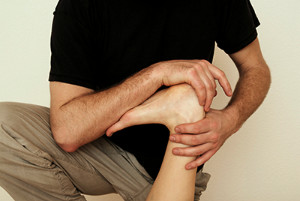
Given the many sources of pain and tightness our feet can endure in life, it behooves us to take regular care of our feet, including stretching them. Moving around in daily life, airplane flights, long car rides, and vigorous exercise can all impact the comfort of our feet. Painful, swollen feet can lead to pain above the feet as well, including the ankles, knees, hips, and back. Stretches can be performed to soothe the feet, improve flexibility, and help with circulation. A few examples of foot stretches include the point and flex exercise, the foot prayer, and the inner ankle stretch. The point and flex exercise is done while sitting on the floor or a workout bench with the feet pointed out in front of you. From this position, point and flex the feet and toes repeatedly. The foot prayer consists of sitting in the same position and then rotating the feet inward, bringing the soles of the feet together. Hold for three seconds before straightening the legs out and repeating. The inner ankle stretch also starts with the feet pointed out in front of you and the feet flexed. The feet should then be rotated outward until a gentle stretch is felt in the inner ankle and foot. As with the prior exercise, stretching should be held for three seconds and repeated. If you regularly suffer from foot pain or tightness and want more information on stretches you can do for your feet, it is suggested that you consult with a podiatrist for further discussion on this issue.
Stretching the feet is a great way to prevent injuries. If you have any concerns with your feet consult with Dean Kim, DPM from Greater Texas Foot & Ankle Specialist. Our doctor will assess your condition and provide you with quality foot and ankle treatment.
Stretching the Feet
Stretching the muscles in the foot is an important part in any physical activity. Feet that are tight can lead to less flexibility and make you more prone to injury. One of the most common forms of foot pain, plantar fasciitis, can be stretched out to help ease the pain. Stretching can not only ease pain from plantar fasciitis but also prevent it as well. However, it is important to see a podiatrist first if stretching is right for you. Podiatrists can also recommend other ways to stretch your feet. Once you know whether stretching is right for you, here are some excellent stretches you can do.
- Using a foam roller or any cylindrical object (a water bottle or soda can will do), roll the object under your foot back and forth. You should also exert pressure on the object. Be sure to do this to both feet for a minute. Do this exercise three times each.
- Similar to the previous one, take a ball, such as a tennis ball, and roll it under your foot while seated and exert pressure on it.
- Grab a resistance band or towel and take a seat. If you are using a towel, fold it length wise. Next put either one between the ball of your foot and heel and pull with both hands on each side towards you. Hold this for 15 seconds and then switch feet. Do this three times for each foot.
- Finally hold your big toe while crossing one leg over the other. Pull the toe towards you and hold for 15 seconds. Once again do this three times per foot.
It is best to go easy when first stretching your foot and work your way up. If your foot starts hurting, stop exercising and ice and rest the foot. It is advised to then see a podiatrist for help.
If you have any questions, please feel free to contact our office located in Frisco, TX . We offer the newest diagnostic and treatment technologies for all your foot care needs.





